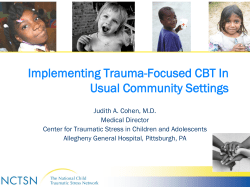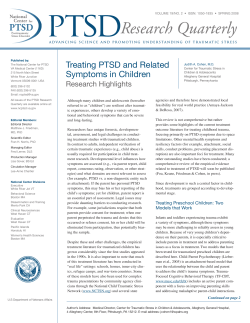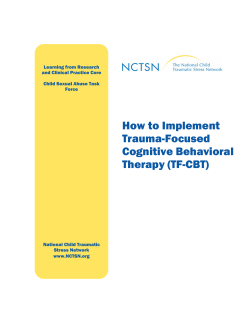
Trauma-Focused Cognitive Behavioral Therapy (TF-CBT)
Trauma-Focused Cognitive Behavioral Therapy (TF-CBT) Treatment Description • • • • • • Target Population • • • • • • • Acronym (abbreviation) for intervention: TF-CBT Average length/number of sessions: Over 80% of traumatized children will show significant improvement with 12-to-16 weeks of treatment (once a week; 60-to-90 minute sessions). Aspects of culture or group experiences that are addressed (e.g., faith/spiritual component, or addresses transportation barriers): TF-CBT has been adapted to address the needs unique to Latino and hearing-impaired/deaf populations, and for children who are experiencing traumatic grief. It is also being adapted for Native American families Trauma type (primary): sexual abuse, traumatic grief, domestic violence, disasters, terrorism, multiple traumatic events Trauma type (secondary): other types of traumatic events Additional descriptors (not included above): The goal of TF-CBT is to help address the biopsychosocial needs of children with Post Traumatic Stress Disorder (PTSD) or other problems related to traumatic life experiences, and their parents or primary caregivers. TF-CBT is a model of psychotherapy that combines trauma-sensitive interventions with cognitive behavioral therapy. Children and parents are provided knowledge and skills related to processing the trauma; managing distressing thoughts, feelings, and behaviors; and enhancing safety, parenting skills, and family communication. Age range: (lower limit) 3 to (upper limit) 18 Gender: Males Females X Both Ethnic/Racial Group (include acculturation level/ immigration/refugee history--e.g., multinational sample of Latinos, recent immigrant Cambodians, multigenerational African Americans): TF-CBT has been tested in Caucasian and African American children as well as Latino children. The modifications of TF-CBT which have been specifically tested for Latino children and for Childhood Traumatic Grief are described under different treatment model descriptions. TF-CBT is currently being adapted for Native American children and for children in other countries (e.g. Zambia, Pakistan, The Netherlands, Germany, etc.). Other cultural characteristics (e.g., SES, religion) : Language(s): The TF-CBT manual is being translated into Dutch and German and being adapted for children of diverse cultural backgrounds as described above. Some of the instruments used to test TF-CBT’s efficacy are currently available in Spanish. Region (.e.g., rural, urban): TF-CBT has been implemented and tested for children in urban, suburban and rural areas. Other characteristics (not included above): TF-CBT is a clinic-based, individual, short-term treatment that involves individual sessions with the child and parent as well as joint parent child sessions. TF-CBT should be provided to those children who have significant behavioral or emotional problems that are related to traumatic life events, even if they do not meet full diagnostic criteria for PTSD. Treatment results in improvements in PTSD symptoms as well as in Trauma-Focused Cognitive Behavioral Therapy (TF-CBT) National Child Traumatic Stress Network www.NCTSN.org 1 depression, anxiety, behavior problems, sexualized behaviors, trauma-related shame, interpersonal trust, and social competence. Essential Components Clinical & Anecdotal Evidence • • Theoretical basis: Cognitive-behavioral, family, empowerment Key components: PRACTICE • Establishing and maintaining therapeutic relationship with child and parent • Psycho-education about childhood trauma and PTSD • Parenting component including parent management skills • Relaxation skills individualized to the child and parent • Affective modulation skills adapted to the child, family and culture • Cognitive coping: connecting thoughts, feelings, and behaviors related to the trauma • Trauma narrative: assisting the child in sharing a verbal, written, or artistic narrative about the trauma(s) and related experiences, and cognitive and affective processing of the trauma experiences • In vivo exposure and mastery of trauma reminders if appropriate • Conjoint parent-child sessions to practice skills and enhance traumarelated discussions • Enhancing future personal safety and enhancing optimal developmental trajectory through providing safety and social skills training as needed • Are you aware of any suggestion/evidence that this treatment may be harmful? Yes xNo Uncertain Extent to which cultural issues have been described in writings about this intervention (scale of 1-5 where 1=not at all to 5=all the time).3 This intervention is being used on the basis of anecdotes and personal communications only (no writings) that suggest its value with this group. Yes NOX Are there any anecdotes describing satisfaction with treatment, drop-out rates (e.g., quarterly/annual reports)? x Yes No If YES, please include citation: All of our treatment studies include drop out statistics (Cohen & Mannarino, 1996; Cohen & Mannarino, 1998; Cohen et al, 2004; Deblinger, et al, 1996). We also have data on client satisfaction for our treatment studies. See below for these publications Has this intervention been presented at scientific meetings? X Yes No If YES, please include citation: Numerous citations available upon request. Are there any general writings which describe the components of the intervention or how to administer it? X Yes No If YES, please include citation: Cohen JA, Mannarino AP, Deblinger E (2006) Treating Trauma and Traumatic Grief in Children and Adolescents. New York: Guilford Press. • • • • • Cohen JA. Mannarino AP (1996a) A treatment study for sexually abused preschool children: Initial findings. J Amer Acad Child & Adol Psychiatry, 35, 42-50. Cohen JA. Mannarino AP (1997) A treatment study of sexually abused preschool children: Outcome during one year follow-up. J Amer Acad Child & Adol Psychiatry, 36, 1228-1235. Cohen JA. Mannarino AP (1998b) Interventions for sexually abused children: Initial Treatment findings. Child Maltreatment, 3, 17-26. Trauma-Focused Cognitive Behavioral Therapy (TF-CBT) National Child Traumatic Stress Network www.NCTSN.org 2 Cohen JA, Mannarino AP, Knudsen K (2005) Treating sexually abused children: One year follow-up of a randomized controlled trial. Child Abuse & Neglect.29, 135-145. Cohen JA, Deblinger E, Mannarino AP, Steer R (2004). A multisite randomized controlled trial for multiply traumatized children with sexual abuse-related PTSD. J Amer Acad Child & Adolescent Psychiatry, 43, (4), 393-402. Deblinger, E., McLeer, S.V. & Henry, D.E. (1990). Cognitive/Behavioral Treatment for Sexually Abused Children Suffering Post-traumatic Stress: Preliminary Findings: Journal of the American Academy of Child and Adolescent Psychiatry, 29 (5), 747-752. Deblinger E, Lippmann J, Steer R (1996) Sexually abused children suffering posttraumatic stress symptoms: Initial treatment outcome findings. Child Maltreatment, 1, 310-321. Deblinger E, Steer R, Lippman J (1999) Two year follow-up study of cognitive behavioral therapy for sexually abused children suffering posttraumatic stress symptoms. Child Abuse & neglect, 23, 1371-1378. Deblinger E, Stauffer LB, Steer RA (2001) Comparative efficacies of supportive and cognitive behavioral group therapies for young children who have been sexually abused and their non-offending mothers. Child Maltreatment,6, 332-343 Deblinger E, Heflin AH (1996) Treating sexually abused children and their nonoffending parents: A cognitive behavioral approach. Thousand Oaks, CA: Sage King, N. J., Tonge, B.J., Mullen, P., Myerson, N., Heyne, D., Rollings, S., Martin, R., Ollendick, T.H. (2000). Treating sexually abused children with posttraumatic stress symptoms: A randomized clinical trial. Journal of the American Academy of Child and Adolescent Psychiatry, 39, 1347-1355. Stauffer, L.B., & Deblinger, E. (1999). Let’s talk about taking care of you: An educational book about body safety. Hatfield, PA: Hope for Families, Inc. (Available from http://www.hope4families.com) • • Research Evidence Has the intervention been replicated anywhere? X Yes No Other countries? (please list) King et al, 2000 Other clinical and/or anecdotal evidence (not included above): Published Case Studies Pilot Trials/ Feasibility Trials (w/o control groups) Clinical Trials Yes No X Yes No Number of Participants N= Sample Breakdown By gender: By ethnicity: N= By other cultural factors: By gender: By ethnicity: N= By other cultural factors: By gender: Trauma-Focused Cognitive Behavioral Therapy (TF-CBT) National Child Traumatic Stress Network www.NCTSN.org 3 Citation (w/ control groups) Randomized Control Trials Yes No X Yes No Studies X describing Yes modifications No Other research evidence: Randomized trial replicating findings by treatment developers • Outcomes X Yes No By ethnicity: N = 551 original participants 453 treatment completers N= By other cultural factors: Treatment completers By gender: 335 female, 118 male By ethnicity: 280 Caucasian, 129 African American, 16 Hispanic American, 15 Biracial, 13 other ethnic background By other cultural factors: By gender: By ethnicity: N = 36 By other cultural factors: By gender: 25 female, 11 male By ethnicity: English speaking Australian children By other cultural factors: Cohen & Mannarino, 1996; Cohen & Mannarino, 1998; Cohen et al, 2004, Deblinger et al, 1996, Deblinger et al, 2001 (see full references below) See CTG for Childhood Traumatic Grief and Culturally Modified TF-CBT for details King et al, 2000 (See full reference below) What assessments or measures are used as part of the intervention or for research purposes, if any? • An initial clinical interview with parent and child • Kiddie-SADS structured interview • Children’s Depression Inventory • State-Trait Anxiety Inventory for Children • Child Behavior Checklist • Child Sexual Behavior Inventory • Children’s Attributions and Perceptions Questionnaire • Parent’s Emotional Reaction Questionnaire • Parental Support Questionnaire • Parenting Practices Questionnaire • Beck Depression Inventory (for parental depression) Trauma-Focused Cognitive Behavioral Therapy (TF-CBT) National Child Traumatic Stress Network www.NCTSN.org 4 • Implementation Requirements and Readiness UCLA PTSD Index If research studies have been conducted, what were the outcomes? A series of randomized controlled trials have demonstrated the superiority of TF-CBT over nondirective play therapy and supportive therapies in children (ages 3 to 14) who have experienced multiple traumas, and those positive results were maintained over time. TF-CBT has proven to be effective in improving PTSD, depression, anxiety, externalizing behaviors, sexualized behaviors, feelings of shame, and mistrust. The parental component of TF-CBT increases the positive effects of TF-CBT for children by improving parents’ own levels of depression, emotional distress about their children’s abuse, support of the child, and parenting practices. • Space, materials or equipment requirements? Private treatment rooms conducive to child comfort and safety • Supervision requirements (e.g., review of taped sessions)? • Clinical supervisors trained and experienced in TF-CBT. • In order for successful implementation, support should be obtained from: • Crime-victims’ compensation funds in some states • Licensed practitioners/programs for Medicaid reimbursement • Insurance companies that provide coverage of ancillary parent sessions for the child who is the identified patient • • List citations for manuals or protocol descriptions and/or where manuals or protocol descriptions can be obtained. Cohen, J.A., Mannarino, A.P., Deblinger, E (2006) Treating Trauma and Traumatic Grief in Children and Adolescents. New York: Guilford Press. • How/where is training obtained? Through the NCTSN TF-CBTLearning Collaborative, TF-CBT Train the Trainer Program, AACAP, APSAC, ISTSS, or other privately arranged trainings. • What is the cost of training? Training through the NCTSN Learning Collaborative is at cost of travel only. Other trainings depend on registration costs of individual conferences. Private trainings cost approximately $20003000/day per trainer plus expenses. • Are intervention materials (handouts) available in other languages? X Yes No If YES, what languages? The TF-CBT treatment manual is being translated into Dutch and German. • Other training materials &/or requirement (not included above): Training sessions are appropriate for supervisors and therapists with a master’s degree or higher. Therapists and clinical supervisors benefit the most from receiving several sequential types of training, which include: • Reading this fact sheet • Completing TF-CBTWeb online training course • Reading the program developers’ treatment book(s) and related materials • Readiness assessment • Intensive skills based training, one to two days • Ongoing expert consultation from trainers for six months • Advanced TF-CBT training, one to two days • Training Materials & Requirements • Pros & Cons/ Qualitative What are the pros of this intervention over others for this specific group (e.g., addresses stigma re. treatment, addresses transportation barriers)? TFCBT currently has strong evidence of efficacy and is flexible in terms of how Trauma-Focused Cognitive Behavioral Therapy (TF-CBT) National Child Traumatic Stress Network www.NCTSN.org 5 Impressions • • clinicians can adapt it for different families. It can be provided over a relatively short period of time and can be provided in a variety of different settings (home, school, clinic, hospital, residential setting, etc.). Although ideally parents or caretakers should be included in treatment, we have provided it to children only when parents have been unable or unwilling to participate. Most community therapists have been positive about adopting TF-CBT with ongoing consultation. What are the cons of this intervention over others for this specific group (e.g., length of treatment, difficult to get reimbursement)?: Some therapists are not amenable to using a structured approach to treatment such as TF-CBT which requires the therapist to encourage children to talk about their traumatic experiences, or to a short-term treatment model which encourages the parent rather than the therapist to be the primary agent of change for the child. Such therapists will likely prefer a different approach. Other qualitative impressions: Name: Judy Cohen, MD, Alleghany General Hospital, Anthony Contact Information Mannarino, PhD, Alleghany General Hospital, or Esther Deblinger, PhD, CARES Institute, UMDNJ-School of Osteopathic Medicine. Address: please contact via e-mail Phone number: Email: jcohen1@wpahs.org, amannari@wpahs.org, deblines@umdnj.edu Website: www.pittsburghchildtrauma.org www.musc.edu/tfcbt Trauma-Focused Cognitive Behavioral Therapy (TF-CBT) National Child Traumatic Stress Network www.NCTSN.org 6
© Copyright 2025
















